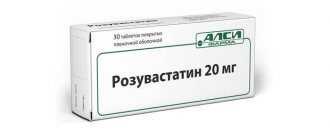pharmachologic effect
Dopamine receptor agonist. Cabergoline is a dopaminergic derivative of ergoline, characterized by a pronounced and long-lasting prolactin-lowering effect. The mechanism of action is associated with direct stimulation of dopamine D2 receptors of lactotropic cells of the pituitary gland. In doses exceeding those for reducing the level of prolactin in the blood plasma, it has a central dopaminergic effect due to stimulation of dopamine D2 receptors.
A decrease in the level of prolactin in the blood plasma is observed 3 hours after taking Dostinex and persists for 7-28 days in healthy volunteers and patients with hyperprolactinemia and up to 14-21 days in women in the postpartum period. The prolactin-lowering effect is dose-dependent both in terms of severity and duration of action.
Cabergoline has a strictly selective effect and, therefore, does not affect the basal secretion of other pituitary hormones, as well as cortisol.
The pharmacological effects of cabergoline that are not associated with a therapeutic effect include a decrease in blood pressure. With a single use of the drug, the maximum hypotensive effect is observed during the first 6 hours and is dose-dependent.
Analogs
There are several substitute drugs for Dostinex. There is a group of synonyms similar in active composition, and analogues - with a different active substance, but with the same therapeutic effect. The following medications can replace the drug:
- Bergolak;
- Agalates;
- Cabergoline;
- Alactin;
- Bromocriptine;
- Parlodel;
- Ronalyn;
- Norprolac;
- Bromocamphor.
Bergolak or Dostinex – which is better?
There are no significant differences between the two drugs, except for the manufacturer. Bergolak also contains 0.5 mg of cabergoline, the same additional components. According to patient reviews, the drug stops lactation on the second day, which is slightly later than when using Dostinex. Bergolak is a generic version of the drug in question, and therefore costs less.
Pharmacokinetics
Suction
After oral administration, cabergoline is rapidly absorbed from the gastrointestinal tract. Cmax in plasma is reached after 0.5-4 hours. Food intake does not affect the absorption and distribution of cabergoline.
Distribution
Css is achieved after 4 weeks of therapy due to the long half-life. Plasma protein binding is 41-42%.
Metabolism
The main product of cabergoline metabolism identified in urine is 6-allyl-8β-carboxy-ergoline at concentrations up to 4-6% of the dose taken. The content of 3 additional metabolites in the urine does not exceed 3% of the dose taken. Metabolic products have a significantly lesser effect in suppressing prolactin secretion compared to cabergoline.
Removal
T1/2, estimated by the rate of excretion in urine, is 63-68 hours in healthy volunteers and 79-115 hours in patients with hyperprolactinemia.
10 days after using the drug, 18% and 72% of the dose taken are found in urine and feces, respectively, with the proportion of unchanged drug in urine being 2-3%.
Dosage regimen
Dostinex ® should be taken orally, preferably during meals.
To prevent lactation
The drug is prescribed in a dose of 1 mg (2 tablets) once on the first day after birth.
To suppress established lactation
prescribed 0.25 mg (1/2 tablet) 2 days.
for 2 days (total dose is 1 mg). In order to reduce the risk of developing orthostatic hypotension in lactating patients, a single dose of Dostinex should not exceed 0.25 mg.
For the treatment of disorders associated with hyperprolactinemia
, the drug is prescribed at a dose of 0.5 mg per week in 1 or 2 doses (1/2 tablet, for example, on Monday and Thursday). The weekly dose should be increased gradually - by 0.5 mg at intervals of 1 month until the optimal therapeutic effect is achieved. The average therapeutic dose is 1 mg per week, but can range from 0.25 mg to 2 mg per week. The maximum dose for patients with hyperprolactinemia is 4.5 mg per week.
Depending on tolerability, the weekly dose can be taken once or divided into 2 or more doses per week. Dividing the weekly dose into several doses is recommended when prescribing the drug at a dose of more than 1 g per week.
In patients with hypersensitivity to dopaminergic drugs, the likelihood of developing side effects can be reduced by starting Dostinex at a lower dose (0.25 mg once a week), followed by a gradual increase until the therapeutic dose is reached. To improve the tolerability of the drug, if severe side effects occur, it is possible to temporarily reduce the dose followed by a gradual increase, for example, by 0.25 mg per week every 2 weeks.
Dostinex for men
If prolactin levels are elevated in men, they are allowed to take the drug Dostinex in the prescribed dosage. A decrease in the hormone in the blood against the background of high testosterone increases a person’s mental stability, his libido, reduces the recovery time between sexual acts, improves sex life and affects the enlargement of the genital organs. Cabergoline is used in bodybuilding to increase endurance and relieve swelling of the muscles and face.
The dosage for men who want to reduce high prolactin levels is 0.25 mg every four days or 0.25 mg every two days. The course lasts until the concentration of the hormone returns to normal - this can be found out by donating blood for a biochemical analysis. You can combine Dostinex with nandrolone or trenbolone steroids. Without drugs with progestin activity, the dose will be 0.5 mg every 10 days. The dosage should not be exceeded; too low a prolactin level in men leads to sexual dysfunction.
Side effect
During clinical studies using Dostinex to prevent and suppress physiological lactation, side effects were observed in approximately 14% of women; in the treatment of disorders associated with hyperprolactinemia, the incidence of adverse events was 68%.
Side effects occurred mainly during the first two weeks of therapy and in most cases disappeared as therapy continued or a few days after Dostinex . In terms of severity, side effects were mild or moderate and were dose-dependent. Severe side effects were observed at least once during therapy in 14% of patients; Treatment was discontinued in 3% of patients due to adverse events.
From the cardiovascular system:
heartbeat; rarely - orthostatic hypotension (with prolonged use, hypotensive effect); asymptomatic decrease in blood pressure during the first 3-4 days after birth (systolic - by more than 20 mm Hg, diastolic - by more than 10 mm Hg).
From the digestive system:
nausea, vomiting, epigastric pain, abdominal pain, constipation, gastritis, dyspepsia.
From the central nervous system and peripheral nervous system:
dizziness/vertigo, headache, fatigue, drowsiness, depression, asthenia, paresthesia, fainting.
Laboratory indicators:
in women with amenorrhea, a decrease in hemoglobin levels during the first months after the restoration of menstruation.
Other:
mastodynia, nosebleeds, “flushes” of blood to the skin of the face, transient hemianopsia, spasms of blood vessels in the fingers, muscle cramps of the lower extremities.
With long-term therapy with Dostinex, deviations from the norm in standard laboratory parameters were rarely observed; Women with amenorrhea experienced a decrease in hemoglobin levels during the first few months after the return of menstruation.
In a post-marketing study, the following adverse reactions associated with the use of cabergoline were recorded: alopecia, increased CPK activity in the blood, mania, dyspnea, edema, fibrosis, liver dysfunction, abnormal liver function tests, hypersensitivity reactions, rash, respiratory disorders, respiratory failure, valvulopathy.
Contraindications to the use of the drug DOSTINEX®
- children and adolescents under 16 years of age (safety and effectiveness of use have not been established);
- hypersensitivity to cabergoline or other components of the drug, as well as to any ergot alkaloids.
Carefully _
the drug is used for arterial hypertension that developed during pregnancy (preeclampsia, postpartum arterial hypertension), severe cardiovascular diseases, Raynaud's syndrome, peptic ulcers, gastrointestinal bleeding, severe liver failure (lower doses are recommended), severe psychotic or cognitive impairment ( including a history), symptoms of impaired cardiac and respiratory function due to fibrotic changes or a history of such conditions, simultaneous use with drugs that have a hypotensive effect (due to the risk of developing orthostatic hypotension).
Overdose
An overdose of Dostinex causes hyperstimulation of dopamine receptors, the symptoms of which include orthostatic arterial hypotension, dyspeptic disorders, nausea, vomiting, hallucinations, confusion, and psychosis. In this case, it is necessary to carry out additional therapeutic measures to remove unabsorbed cabergoline (mainly gastric lavage) and, if necessary, normalize blood pressure. It is also possible to prescribe dopamine antagonists.
Use of the drug DOSTINEX® during pregnancy and breastfeeding
Since there have been no controlled clinical studies using Dostinex in pregnant women, use of the drug during pregnancy is possible only if the expected benefit to the mother outweighs the potential risk to the fetus.
If pregnancy occurs during treatment with Dostinex , the advisability of discontinuing the drug should be considered, also taking into account the benefit/risk ratio.
Pregnancy should be avoided for at least 1 month after discontinuation of the drug, given its long half-life and limited data on effects on the fetus. According to available data, the use of Dostinex at a dose of 0.5-2 mg per week for disorders associated with hyperprolactinemia was not accompanied by an increase in the incidence of miscarriages, premature births, multiple pregnancies and congenital malformations.
There is no information about the excretion of the drug in breast milk, however, if there is no effect of using Dostinex to prevent or suppress lactation, breastfeeding should be discontinued. For disorders associated with hyperprolactinemia, Dostinex ® should not be prescribed to patients who do not want to stop lactation.
Dostinex price
You can buy Dostinex via the Internet or pharmacy chains. The cost of the drug depends on the number of tablets in the package and the accepted trade markup. Prices for the drug in Moscow pharmacies will be:
| Type of medicine | Pharmacy | Price of tablets, in rubles |
| Tablets 0.5 mg 2 pcs. | Pills.ru | 659 |
| Dialogue | 576 | |
| Zdravzona | 622 | |
| Beauty and health laboratory | 681 | |
| Tablets 0.5 mg 8 pcs. | Pills.ru | 1832 |
| Dialogue | 1499 | |
| Zdravzona | 1875 | |
| Beauty and health laboratory | 1804 |
special instructions
Before prescribing Dostinex for the treatment of disorders associated with hyperprolactinemia, it is necessary to conduct a complete study of pituitary function.
When increasing the dose, the patient should be under medical supervision in order to establish the lowest effective dose that provides a therapeutic effect. After selecting an effective dosage regimen, it is recommended to regularly (once a month) determine the level of prolactin in the blood serum. Normalization of prolactin levels is usually observed within 2-4 weeks of treatment.
Orthostatic hypotension may develop after using Dostinex Dostinex should be prescribed with caution during therapy with drugs that have a hypotensive effect.
During long-term therapy, Dostinex ® should be prescribed in lower doses to patients with severe hepatic impairment (Child-Pugh class C) who are indicated for long-term therapy with Dostinex . With a single dose of 1 mg in these patients, an increase in AUC was observed compared to healthy volunteers and patients with less severe hepatic impairment.
Pleural effusion/pleural fibrosis and valvulopathy have been observed in patients following long-term use of cabergoline. In some cases, patients had received prior therapy with ergotinine dopamine agonists. Therefore, Dostinex ® should be used with caution in patients with existing signs and/or clinical symptoms of cardiac dysfunction (including a history). After discontinuation of the drug, patients experienced improvement in the above-described symptoms.
After discontinuation of Dostinex, a relapse of hyperprolactinemia is usually observed. However, some patients experience persistent suppression of prolactin levels for several months. Most women experience ovulatory cycles for at least 6 months after stopping Dostinex .
Dostinex ® restores ovulation and fertility in women with hyperprolactinemic hypogonadism. Since pregnancy can occur even before menstruation returns, it is recommended to carry out pregnancy tests at least once every 4 weeks during the amenorrhea period, and after menstruation returns - whenever a delay of more than 3 days is noted. Women who want to avoid pregnancy should use non-hormonal methods of contraception with Dostinex , as well as after discontinuation of Dostinex
Women who become pregnant should be under medical supervision to promptly identify symptoms of an enlarged pituitary gland, since pre-existing pituitary tumors may increase in size during pregnancy.
The use of cabergoline causes drowsiness. In patients with Parkinson's disease, the use of dopamine receptor agonists may cause sudden sleep onset. In such cases, it is recommended to reduce the dose of Dostinex or discontinue therapy.
No studies have been conducted on the use of the drug in elderly patients with disorders associated with hyperprolactinemia.
Use in pediatrics
Safety and effectiveness of Dostinex in children and adolescents under 16 years of age
not installed.
Impact on the ability to drive vehicles and operate machinery
Patients taking Dostinex ® who experience drowsiness should be cautioned to avoid driving or performing work in which decreased alertness could put them or others at risk of serious injury or death.
Special information
If taking Dostinex for elevated prolactin is ineffective, then the cause of the development of hyperprolactinemia in this particular patient should be sought in another area.
Women treated with this drug for a long period of time should undergo regular gynecological examination with mandatory cervical gynecological examination and histological examination of the endometrium.
During treatment with Dostinex, it is necessary to constantly monitor blood pressure and the functioning of the gastrointestinal tract due to the potential danger of bleeding. In addition, patients taking Dostinex (reviews for elevated prolactin focus on such facts) should not engage in, or at least for some time should refrain from, engaging in potentially hazardous activities that require high concentration and increased speed of psychomotor reactions .
Drug interactions
There is no information on interactions between cabergoline and other ergot alkaloids; however, the simultaneous use of these drugs during long-term therapy with Dostinex is not recommended.
Since Dostinex ® exerts a therapeutic effect by direct stimulation of dopamine receptors, the drug cannot be prescribed simultaneously with drugs that act as dopamine antagonists (for example, phenothiazines, butyrophenones, thioxanthenes, metoclopramide), because the latter may weaken the prolactin-lowering effect of Dostinex .
Like other ergot derivatives, Dostinex ® should not be used simultaneously with macrolide antibiotics (for example, erythromycin), as this may lead to an increase in the systemic bioavailability of cabergoline.










